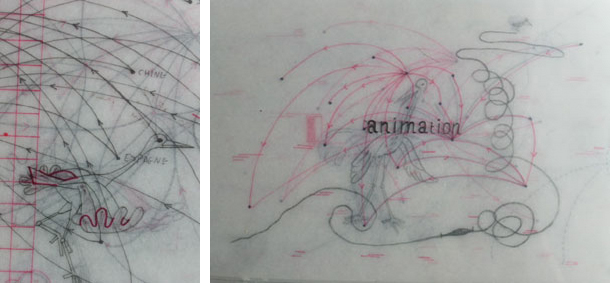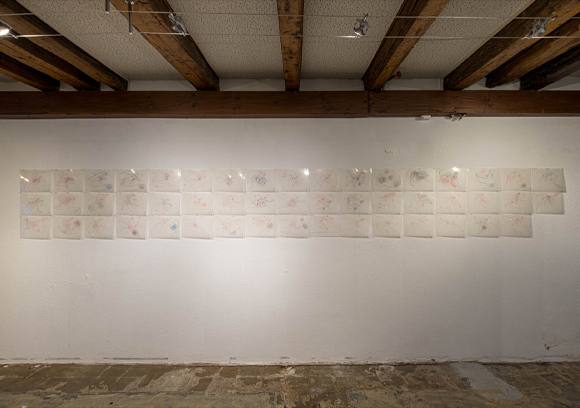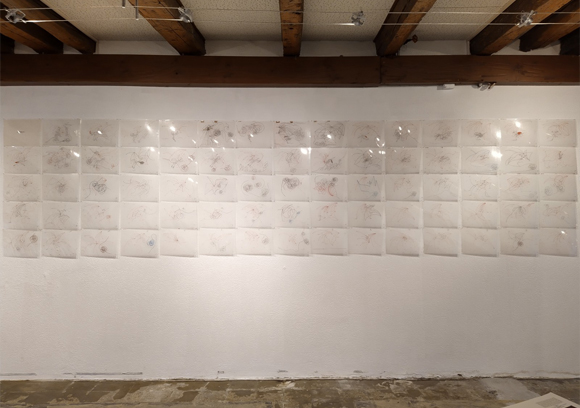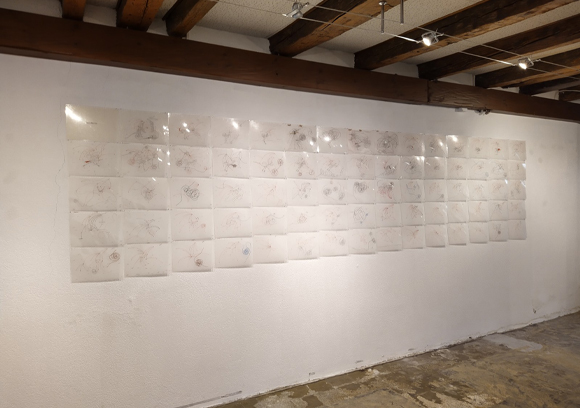| |
|
|
05.
| Animation |
| |


1998-1999, drawings on laminated layer, serie of 74 pieces, 30 x 21,5 cm.
Exhibition view from Paris-Casa, suites marocaines, Couvent des Cordeliers, 1999, Paris.
Artist's collection.
'' By juxtaposing them, « Animation » creates a connection between chance and necessity, formalism and poetic sensitivity,
with the image of the migrating wading bird as a central and symbolic figure: a symbol of the quest for self, of the emigrant traveling by necessity
and of the traveler whose flight doesn’t concern itself with customs and borders and only answers to internal necessities. ''
Studio Fatmi, December 2017

Animation
View from the exhibition Keeping Faith - Keeping Drawing, Analix Forever, Geneva, 2019.
Courtesy of the artist.

Animation
View from the exhibition Keeping Faith - Keeping Drawing, Analix Forever, Geneva, 2019.
Courtesy of the artist.

Animation
View from the exhibition Keeping Faith - Keeping Drawing, Analix Forever, Geneva, 2019.
Courtesy of the artist.
|
|
|
|
|
|
« Animation » regroupe une série de dessins commencée en 1998, dont le projet doit aboutir à une animation vidéo. Réalisées sur papier stratifié, des compositions graphiques dont les couleurs sont principalement le rouge, le noir et le blanc, traversent les pages blanches avec des inflexions filaires, exécutant des séries de courbes et de boucles qui s'entortillent à la manière d'un câble électrique ou d'un cordon ombilical, et auxquelles se superposent les fines silhouettes de cigognes ainsi que divers noms de pays. L'association de ces trois couleurs est typique du dessin de mounir fatmi et elle tend à former un code chromatique à la fois symbolique et émotionnel, où le rouge est la couleur du lien, le blanc celle de la séparation ou de l'oubli et le noir, celle qui permet de donner une forme au moins provisoire à des apparitions graphiques instables et fragiles, parfois proches de l'évanescence.
Inspiré des cartes géographiques et des itinéraires de vol migratoire des cigognes, le projet a pour thèmes l'exil et le déplacement - sujets récurrents dans les œuvres de mounir fatmi, qui se définit comme un « travailleur immigré » : « (…) je me pose la question de l’exil, ou plus précisément, c’est la question de l’exil qui s’est toujours posée à moi. Ayant volontairement quitté le Maroc, j’ai vécu dès lors avec la conscience aiguë de la séparation, du déplacement, du poids de l’identité. J’ai inscrit alors ma démarche dans ce déplacement permanent (…) » (mounir fatmi, texte du projet « Les Pavillons de l’exil », juin 2016) Ce questionnement est mené dans les expositions personnelles intitulées « L'Art de la guerre » (2014) ou « Permanent exil » (2015), ainsi que dans des projets collectifs initiés par mounir fatmi, dont les récents « Art en exil » qui s'est tenu à Bruxelles et « Pavillons de l’exil », à la 57ème Biennale de Venise.
L'esthétique des dessins de la série « Animation » s'inspire du trait libre et des techniques de dripping de Jackson Pollock, et elle peut s'observer dans d'autres projets graphiques, tels que la série « Désorientations », expérimentation graphique de l'égarement et du dés-apprentissage dans le but d'inventer son propre cheminement, à la fois existentiel et esthétique. Ce thème de la quête initiatique est également abordée dans une installation aviaire de mounir fatmi, « Le Langage des oiseaux » (2001-2004). L'œuvre s'inspire du recueil de poèmes soufi « La conférence des oiseaux » (1177), qui traite de la quête mystique de soi à travers les thèmes du voyage et de la transmission. « Animation » se propose, dans une acception proche de son étymologie, comme une tentative pour recomposer le mouvement et pour avoir une vue d'ensemble sur une série de déplacements. L'œuvre pourrait ainsi faire allusion aux (très nombreux) voyages effectués en avion par l'artiste au cours de ses années de travail par exemple, et tenter de les répertorier. Les dessins ont cependant une approche à la fois plus générale et personnelle et prennent en compte non seulement des déplacements spatiaux mais également des périples intérieurs.
Les dessins de la série « Animation » font ainsi se superposer de types d'itinéraires. Ils suivent la piste d'un parcours tracé par des déplacements géographiques obéissant à des nécessités matérielles : de la même manière que les migrations des cigognes répondent à différentes contraintes, climatiques et géographiques… Ou que celles des humains sont soumises aux conditions géopolitiques, techniques ou douanières des territoires qu'elles traversent… Les lignes courbes qui courent à travers les dessins tentent surtout de suivre l'itinéraire du geste libre, d'une écriture automatique libérée des contraintes - errance graphique livré au hasard et fil d'Ariane menant aux chemins de la création artistique et du désir. « Animation » fait le lien, en les juxtaposant, entre hasard et nécessité, formalisme et sensibilité poétique, avec pour figure centrale et symbolique, l'image de l'échassier migrateur : à la fois figure de la quête de soi, de l'émigré par nécessité et du voyageur dont le vol s'affranchit des douanes et des frontières et répond à des nécessités intérieures.
Studio Fatmi, decembre 2017.
|
|
« Animation »gathers a series of drawings initiated in 1998 for a project destined to become a video animation. These are graphic compositions on stratified paper whose main colors are red, black and white. They cut through the white pages with wiry bends, creating a series of curves and loops that twist and wind like an electric wire or an umbilical cord, onto which are superimposed the thin silhouettes of storks, along with the names of various countries. The association of these three colors is characteristic of mounir fatmi’s drawings and creates a chromatic code that is both symbolic and emotional, where red is the color of connections, white the color of separation or oblivion and black the one that is able to provide a physical form, at least temporarily, to these instable and fragile graphic appearances that are sometimes close to evanescence.
Inspired by geographic maps and the itineraries of storks’ migration patterns, the project’s theme is exile and displacement – recurrent subjects in mounir fatmi’s work, who defines himself as an « immigrant worker »: « I ask myself the question of exile, or rather, the question of exile was always posed to me. Having voluntarily left Morocco, I have lived since then with an acute sense of separation, displacement, the weight of identity. I therefore placed my work under this idea of permanent displacement (…) » (mounir fatmi, text for the project « Exile Pavilions », June 2016). This interrogation was carried out through the personal exhibits « The Art of War » (2014) or « Permanent Exile » (2015), as well as in collective projects initiated by mounir fatmi, among which the recent « Art in Exile », shown in Brussels, and « Exile Pavilions » at the 57th Venice Biennale.
The esthetic of the drawings in the « Animation » series is inspired by free line drawing and Jackson Pollock’s dripping techniques, and can be seen in other graphic projects such as « Disorientations », a graphic experimentation of distraction and un-learning in order to create one’s own path, both existentially and esthetically. This theme of the initiatory quest is also addressed in an avian installation by mounir fatmi: « Bird Language » (2001-2004). This work is inspired by the collection of Sufi poems « The Conference of the Birds » (1177), which is about the mystic quest for self through the themes of travel and transmission. « Animation » offers, with an acceptation that is close to the title’s etymology, an attempt to recompose movement and obtain a general view of a series of displacements. As such, the work could for example be referencing the (many) plane trips made by the artist over the course of his years of work, and try to inventory them. Yet the drawings have a simultaneously more general and more personal approach and take into account not only spatial displacements but also interior journeys.
In this way, the drawings of the « Animation » series superimpose several types of itineraries. They follow the path of a course traced by geographic movements guided by material necessities: just like the migrations of storks are guided by climatic and geographical constraints, those of humans are dependent on the geopolitical, technical or border-related conditions of the territories they go through. More than anything, the curved lines that run through the drawings are trying to follow the itinerary of free gestures, that of an automatic writing devoid of any constraints – a graphic wandering left to chance, like an Ariadne’s thread leading to the paths of artistic creation and desire. By juxtaposing them, « Animation » creates a connection between chance and necessity, formalism and poetic sensitivity, with the image of the migrating wading bird as a central and symbolic figure: a symbol of the quest for self, of the emigrant traveling by necessity and of the traveler whose flight doesn’t concern itself with customs and borders and only answers to internal necessities.
Studio Fatmi, December 2017. |
|
|
|